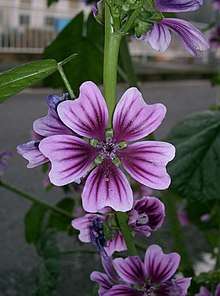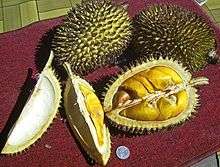Malvaceae
Malvaceae, or the mallows, is a family of flowering plants estimated to contain 244 genera with 4225 known species.[3][4] Well-known members of economic importance include okra, cotton, cacao and durian. There are also some genera containing familiar ornamentals, such as Alcea (hollyhock), Malva (mallow) and Lavatera (tree mallow), as well as Tilia (lime or linden tree). The largest genera in terms of number of species include Hibiscus (300 species), Sterculia (250 species), Dombeya (250 species), Pavonia (200 species) and Sida (200 species).[5]
| Malvaceae | |
|---|---|
 | |
| Least mallow, Malva parviflora | |
| Scientific classification | |
| Kingdom: | Plantae |
| Clade: | Tracheophytes |
| Clade: | Angiosperms |
| Clade: | Eudicots |
| Clade: | Rosids |
| Order: | Malvales |
| Family: | Malvaceae Juss.[1] |
| Subfamilies | |
| Synonyms[2] | |
| |
Taxonomy and nomenclature


The circumscription of the Malvaceae is controversial. The traditional Malvaceae sensu stricto comprise a very homogeneous and cladistically monophyletic group. Another major circumscription, Malvaceae sensu lato, has been more recently defined on the basis that molecular techniques have shown the commonly recognised families Bombacaceae, Tiliaceae, and Sterculiaceae, which have always been considered closely allied to Malvaceae s.s., are not monophyletic groups. Thus, the Malvaceae can be expanded to include all of these families so as to compose a monophyletic group. Adopting this circumscription, the Malvaceae incorporate a much larger number of genera.
Subfamilies
This article is based on the second circumscription, as presented by the Angiosperm Phylogeny Website.[4] The Malvaceae s.l. (hereafter simply "Malvaceae") comprise nine subfamilies. A tentative cladogram of the family is shown below. The diamond denotes a poorly supported branching (<80%).
| |||||||||||||||||||||||||||||||||||||
It is important to point out the relationships between these subfamilies are still either poorly supported or almost completely obscure. There are continuing disagreements over the correct circumscription of these subfamilies, including the preservation of the family, Bombacaceae.[6] The circumscription of the family may change dramatically as new studies are published.
If looking for information about the traditional Malvaceae s.s., we recommend referring to Malvoideae, the subfamily that approximately corresponds to that group.
Synapomorphies
The relationships between the "core Malvales" families used to be defined on the basis of shared "malvean affinities". These included the presence of malvoid teeth, stems with mucilage canals, and stratified wedge-shaped phloem.[7] These affinities were problematic because they were not always shared within the core families.[8] Later studies revealed more unambiguous synapomorphies within Malvaceae s.l.. Synapomorphies identified within Malvaceae s.l. include the presence of tile cells, trichomatous nectaries, and an inflorescence structure called a bicolor unit.[9] Tile cells consist of vertically positioned cells interspersed between and dimensionally similar to procumbent ray cells. Evidence of Malvean wood fossils have confirmed their evolutionary link in Malvaceae s.l., as well explained their diverse structures.[10] Flowers of Malvaceae s.l. exhibit nectaries consisting of densely arranged multicellular hairs resembling trichomes. In most of Malvaceae s.l., these trichomatous nectaries are located on the inner surface of the sepals, but flowers of the subfamily, Tiliodeae, also have present nectaries on the petals.[11] Malvean flowers also share a unifying structure known as a bicolor unit, named for its initial discovery in the flowers of Theobroma bicolor. The bicolor unit consists of an ordered inflorescence with determinate cymose structures. The inflorescence can branch off the main axis, creating separate orders of the flowers, with the main axis developing first. Bracts on the peduncle subtend axillary buds that become these lateral stalks. One bract within this whorl is a sterile bract. The bicolor unit is a variable structure in complexity, but the presence of fertile and sterile bracts is a salient character.[12]
Names
The English common name 'mallow' (also applied to other members of Malvaceae) comes from Latin malva (also the source for the English word "mauve"). Malva itself was ultimately derived from the word for the plant in ancient Mediterranean languages.[13] Cognates of the word include Ancient Greek μαλάχη (malákhē) or μολόχη (molókhē), Modern Greek μολόχα (molóha), modern Arabic: ملوخية (mulukhiyah) and modern Hebrew: מלוחיה (molokhia).[13][14]
Description

Most species are herbs or shrubs, but some are trees and lianas.
Leaves and stems

Leaves are generally alternate, often palmately lobed or compound and palmately veined. The margin may be entire, but when dentate, a vein ends at the tip of each tooth (malvoid teeth). Stipules are present. The stems contain mucous canals and often also mucous cavities. Hairs are common, and are most typically stellate. Stems of Bombacoideae are often covered in thick prickles.[15]
Flowers
The flowers are commonly borne in definite or indefinite axillary inflorescences, which are often reduced to a single flower, but may also be cauliflorous, oppositifolious, or terminal. They often bear supernumerary bracts in the structure of a bicolor unit.[12] They can be unisexual or bisexual, and are generally actinomorphic, often associated with conspicuous bracts, forming an epicalyx. They generally have five valvate sepals, most frequently basally connate, with five imbricate petals. The stamens are five to numerous, and connate at least at their bases, but often forming a tube around the pistils. The pistils are composed of two to many connate carpels. The ovary is superior, with axial placentation, with capitate or lobed stigma. The flowers have nectaries made of many tightly packed glandular hairs, usually positioned on the sepals.[11]
Pollination
Self-pollination is often avoided by means of protandry. Most species are entomophilous (pollinated by insects). Bees from the tribe Emphorini of the Apidae (including Ptilothrix, Diadasia, and Melitoma) are known to specialize on the plants.
Importance
A number of species are pests in agriculture, including Abutilon theophrasti and Modiola caroliniana, and others that are garden escapes. Cotton (four species of Gossypium), kenaf (Hibiscus cannabinus), cacao (Theobroma cacao), kola nut (Cola spp.), and okra (Abelmoschus esculentus) are important agricultural crops. The fruit and leaves of baobabs are edible, as is the fruit of the durian. A number of species, including Hibiscus syriacus, Hibiscus rosa-sinensis and Alcea rosea are garden plants.
See also
- Florissantia, an extinct Cenozoic genus
References
- Angiosperm Phylogeny Group (2009). "An update of the Angiosperm Phylogeny Group classification for the orders and families of flowering plants: APG III". Botanical Journal of the Linnean Society. 161 (2): 105–121. doi:10.1111/j.1095-8339.2009.00996.x.
- "Family: Malvaceae". Germplasm Resources Information Network (GRIN) [Online Database]. United States Department of Agriculture Agricultural Research Service, Beltsville, Maryland. 17 January 2017. Retrieved 7 June 2017.
- Christenhusz, M. J. M.; Byng, J. W. (2016). "The number of known plants species in the world and its annual increase". Phytotaxa. 261 (3): 201–217. doi:10.11646/phytotaxa.261.3.1.
- "Angiosperm Phylogeny Website". Retrieved 15 July 2014.
- Judd, W.S.; Campbell, C.S.; Kellogg, E.A.; Stevens, P.F.; Donoghue, M.J. (2008). Plant Systematics: A Phylogenetic Approach (3rd ed.). ISBN 978-0878934072.
- Refaat, J. (2012). "Bombacaceae: A phytochemical review". Pharmaceutical Biology. 51 (1): 100–130. doi:10.3109/13880209.2012.698286. PMID 22974340.
- Kubitzki, K. (2003). The Families and Genera of Vascular Plants. Berlin: Springer-Verlag.
- Thorne, R (1992). "Classification and geography of the flowering plants". Bot. Rev. 58 (3): 225–348. doi:10.1007/bf02858611.
- Bayer, C. (1999). "Support for an expanded family concept of Malvaceae within a recircumscribed order Malvales: a combined analysis of plastid atpB and rbcL DNA sequences". Botanical Journal of the Linnean Society. 129 (4): 267–303. doi:10.1111/j.1095-8339.1999.tb00505.x.
- Manchester, Steven; Miller, Regis B. (1978). "Tile cells and their occurrence in Malvalean fossil woods". IA WA Bulletin: 23–28 – via ResearchGate.
- Erbar, Claudia (2014). "Nectar secretion and nectaries in basal angiosperms, magnoliids and non-core eudicots and a comparison with core eudicots". Plant Diversity and Evolution. 131 (2): 63–143. doi:10.1127/1869-6155/2014/0131-0075.
- Bayer, C (1999). "The bicolor unit — homology and transformation of an inflorescence structure unique to core Malvales". Plant Systematics and Evolution. 214 (1–4): 187–198. doi:10.1007/bf00985738.
- Douglas Harper. "mallow". Online Etymology Dictionary. Retrieved February 3, 2012.
- Khalid. "Molokheya: an Egyptian National Dish". The Baheyeldin Dynasty. Retrieved September 10, 2011.
- Heywood, Vernon Hilton; Brummitt, R. K.; Culham, A.; Seberg, O. (2007). Flowering Plant Families of the World. Richmond Hill, Ontario, Canada: Firefly Books. ISBN 9781554072064.
- Baum, D. A.; W. S. Alverson; R. Nyffeler (1998). "A durian by any other name: taxonomy and nomenclature of the core Malvales". Harvard Papers in Botany. 3: 315–330.
- Baum, D. A.; Dewitt Smith, S.; Yen, A.; Alverson, W. S.; Nyffeler, R.; Whitlock, B. A.; Oldham, R. L. (2004). "Phylogenetic relationships of Malvatheca (Bombacoideae and Malvoideae; Malvaceae sensu lato) as inferred from plastid DNA sequences". American Journal of Botany. 91 (11): 1863–1871. doi:10.3732/ajb.91.11.1863. PMID 21652333.
- Bayer, C. (1999). "Support for an expanded family concept of Malvaceae within a recircumscribed order Malvales: a combined analysis of plastidatpB andrbcL DNA sequences". Botanical Journal of the Linnean Society. 129 (4): 267–303. doi:10.1006/bojl.1998.0226.
- Bayer, C. and K. Kubitzki 2003. Malvaceae, pp. 225–311. In K. Kubitzki (ed.), The Families and Genera of Vascular Plants, vol. 5, Malvales, Capparales and non-betalain Caryophyllales.
- Edlin, H. L. (1935). "A Critical Revision of Certain Taxonomic Groups of the Malvales Part Ii1". New Phytologist. 34 (2): 122–143. doi:10.1111/j.1469-8137.1935.tb06834.x.
- Judd, W. S.; Manchester, S. R. (1997). "Circumscription of Malvaceae (Malvales) as Determined by a Preliminary Cladistic Analysis of Morphological, Anatomical, Palynological, and Chemical Characters". Brittonia. 49 (3): 384–405. doi:10.2307/2807839. JSTOR 2807839.
- Maas, P. J. M. and L. Y. Th. Westra. 2005. Neotropical Plant Families (3rd edition).
- Perveen, A.; Grafström, E.; El-Ghazaly†, G. (2004). "World Pollen and Spore Flora 23. Malvaceae Adams. P.p. Subfamilies: Grewioideae, Tilioideae, Brownlowioideae". Grana. 43 (3): 129. doi:10.1080/00173130410000730. ISSN 0017-3134.
- Tate, J. A., J. F. Aguilar, S. J. Wagstaff, J. C. La Duke, T. A. Bodo Slotta and B. B. Simpson (2005). "Phylogenetic relationships within the tribe Malveae (Malvaceae, subfamily Malvoideae) as inferred from ITS sequence data" (PDF). American Journal of Botany. 92 (4): 584–602. doi:10.3732/ajb.92.4.584. hdl:10261/24879. PMID 21652437.CS1 maint: multiple names: authors list (link) (abstract online here).
- Alverson, William S.; Whitlock, Barbara A.; Nyffeler, Reto; Bayer, Clemens; Baum, David A. (1999). "Phylogeny of the core Malvales: evidence from ndhF sequence data". American Journal of Botany. 86 (10): 1474–1486. doi:10.2307/2656928. JSTOR 2656928. PMID 10523287.
External links
| Wikispecies has information related to Malvaceae |
| Wikimedia Commons has media related to Malvaceae. |
